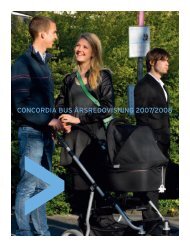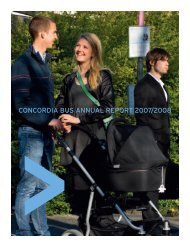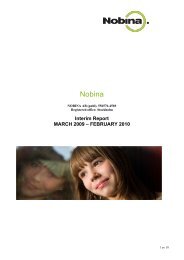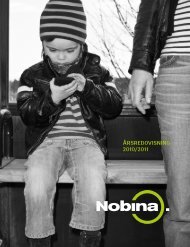Annual Report 2012/2013 5.09 MB - Nobina AB
Annual Report 2012/2013 5.09 MB - Nobina AB
Annual Report 2012/2013 5.09 MB - Nobina AB
- No tags were found...
You also want an ePaper? Increase the reach of your titles
YUMPU automatically turns print PDFs into web optimized ePapers that Google loves.
DRIVING FORCES AND COUNTERFORCES1FAVOUR<strong>AB</strong>LE23456DEVELOPMENT OF PUBLIC TRANSPORTIn our markets, there is stable, long-term growth inthe demand for public transport, which is fuelled bya growing demand for mobility in society, ongoingurbanization and the desire of politicians and passengersalike to reduce environmental impact. Theindustry has also established the goal of doublingtravel by public transport by 2020. The Nordicmodel for publicly tendered public transport continuesto apply in all of the Nordic countries, with continuedgrowth in volume in major regions.DEREGULATION INCREASES OUR AVAIL<strong>AB</strong>LE MARKETThe deregulation initiatives that have been implementedin the Nordic countries are making anincreasingly greater impact. With the expiration ofold contracts, more and more municipalities andcounty councils are deciding to contract out theirlocal and regional traffic. Future tendering processesoffer many business opportunities, particularly whenthe terms and conditions are more flexible.SUSTAIN<strong>AB</strong>ILITY AND HOLISTIC APPROACHOPPORTUNITIES IN THE VALUE CHAIN<strong>Nobina</strong>’s turnaround to profitable operations a fewyears ago was possible because of a change in howwe view our own business. We evolved from deliveringbus services to managing and developing acontract portfolio and creating value for passengers.This shift of perspective creates a wider valueDYSFUNCTIONAL TENDERING MODELSAlthough the methods for tendering and contractingpublic transport services are becoming moreflexible, and some parts are being deregulated,many dysfunctional tendering models still exist.Many focus on price rather than quality, productionrather than the actual services delivered,More and more people are starting to understandthe importance of a sustainable development ofsociety and the role of public transport in attainingthat goal. Besides the obvious environmental benefitsof more people travelling together, a well-functioningpublic transport system also helps makehousing areas more attractive and companies/workplacesmore accessible. Furthermore, fewer parkingspaces are required and it reduces wear and tear onthe infrastructure. Personal injuries are alsoreduced. A recent study confirmed that travel bybus is the safest mode of transportation. A sustainable,holistic approach recognizes the benefits ouroperations can provide.chain in which many business opportunities arestill waiting to be explored. As the market leader,we have a unique ability to push developmenttowards a more functional market, with higherprofitability and greater benefits to society and endcustomersalike.details rather than overall functionality and politicalstandpoints rather than the benefits to societyand passengers. There are many obstacles in theway for private companies and public operators thatare trying to create a better offering at a lower costto society.A SECTOR THAT STRUGGLES WITH PROFIT<strong>AB</strong>ILITY –LUKEWARM INTEREST FROM FINANCIERS<strong>Nobina</strong> has demonstrated its ability to provide publicbus services at a profit. However, profitabilitythroughout this sector remains elusive. Publiclyowned traffic operators underestimate the risks andhave a high tolerance for losses, which causes theirown profitability and that of the entire sector todeteriorate. The low profitability of this sector is adeterrent to new, skilled entrants. It also makes itdifficult to attract capital.9











